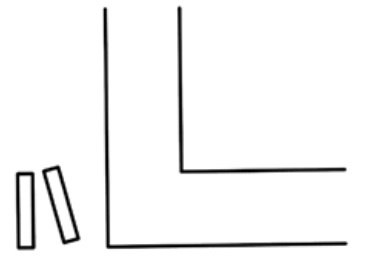To cross the river
A river of 4 meters wide has a curve of 90 °. Is it possible to cross the river by making a bridge with only two planks 3.9 meters long each?

Details and assumptions:
- He has no nails, no hammers, nothing of the sort.
This section requires Javascript.
You are seeing this because something didn't load right. We suggest you, (a) try
refreshing the page, (b) enabling javascript if it is disabled on your browser and,
finally, (c)
loading the
non-javascript version of this page
. We're sorry about the hassle.
Using one plank diagonally across the outside corner (forming an isosceles triangle), and the other perpendicular from the first plank to the inside corner, we can create a self-supporting bridge.
The distance we need to cover, from the outside corner to the inside corner, is 4 m 2 + 4 m 2 = 5 . 6 5 7 m
Allowing 0 . 0 5 m for support at each end of the planks, the first diagonal plank will effectively achieve a distance of 2 3 . 8 m = 1 . 9 m from the outside corner (due to the symmetry of the isosceles triangle).
This leaves 5 . 6 5 7 m − 1 . 9 m = 3 . 7 5 7 m to cover with the remaining plank, which is certainly possible with a plank of 3 . 9 m , even with an allowance at either end of the plank for support.
If the planks had negligible width, they would have to be greater than 3 2 4 m 2 + 4 m 2 = 3 . 7 7 1 2 3 6 1 6 6 3 2 8 2 5 m in length to be able to form a self-supporting bridge.